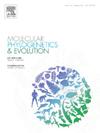新岛种阐明了新热带鳄鱼的物种复合体
IF 3.6
1区 生物学
Q2 BIOCHEMISTRY & MOLECULAR BIOLOGY
引用次数: 0
摘要
新热带鳄鱼的进化史仍然难以捉摸。它们居住的地理范围很广,从沿海、内陆到岛屿都有。通过对天然岛屿种群、沿海种群和一个内陆种群、沿海种群和单幸存种群的研究,我们发现了该群体显著的遗传多样性。此外,颅骨形状的几何形态测量结果表明,这些鳄鱼物种跨越形态渐变。我们恢复了C. morreletii, C. rhombifer和5个簇尖C. acutus之间的高度遗传分化。研究人员利用不同种群间的遗传和地理差异来推测它们可能是一个物种复合体。在墨西哥尤卡坦半岛附近的Banco Chinchorro和Cozumel岛的种群中发现了一些生态,形态和遗传学特征,以支持这些种群的离散物种名称。这项工作表明,在整个新热带地区,存在着几种隐鳄的快速、最近的进化。本文章由计算机程序翻译,如有差异,请以英文原文为准。

Novel island species elucidate a species complex of Neotropical crocodiles
The evolutionary history of Neotropical crocodiles has remained elusive. They inhabit a broad geographic range with populations spanning from coastal, inland, and insular locations. Using a selection of natural insular, coastal, and one inland population of C. acutus, coastal C. moreletii, and the single surviving population of C. rhombifer, we discovered a remarkable genetic diversity for the group. Moreover, geometric morphometric results of skull shapes shows that these crocodylus species span a morphological cline. We recovered a high genetic differentiation between C. moreletii, C. rhombifer, and five clusters of C. acutus. The genetic and geographic differences among the C. acutus clusters were used to suggest these may be a species complex. Several ecological, morphological and genetics traits are identified in the well-studied populations from Banco Chinchorro and Cozumel islands off the Mexican Yucatan Peninsula to support discrete species designations for these populations. This work suggests the presence of rapid, recent evolution of several cryptic Crocodylus species throughout the Neotropics.
求助全文
通过发布文献求助,成功后即可免费获取论文全文。
去求助
来源期刊
CiteScore
7.50
自引率
7.30%
发文量
249
审稿时长
7.5 months
期刊介绍:
Molecular Phylogenetics and Evolution is dedicated to bringing Darwin''s dream within grasp - to "have fairly true genealogical trees of each great kingdom of Nature." The journal provides a forum for molecular studies that advance our understanding of phylogeny and evolution, further the development of phylogenetically more accurate taxonomic classifications, and ultimately bring a unified classification for all the ramifying lines of life. Phylogeographic studies will be considered for publication if they offer EXCEPTIONAL theoretical or empirical advances.

 求助内容:
求助内容: 应助结果提醒方式:
应助结果提醒方式:


